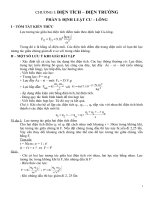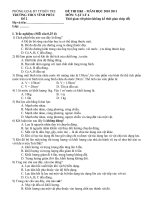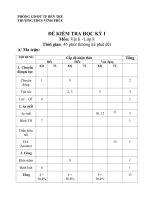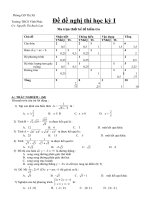Tham khảo mô hình i o
Bạn đang xem bản rút gọn của tài liệu. Xem và tải ngay bản đầy đủ của tài liệu tại đây (221.04 KB, 50 trang )
Input-Output Models
Inter-Industry Structure
URBPL 5/6020, University of Utah
Pam Perlich
Input - Output Analysis
Wassily Leontief created the model.
He first published it in 1965.
He received a Nobel Prize in 1973 for
this work.
A review of his work is in the March
1999 Survey of Current Business.
Input Output Models
Capture inter-industry transactions:
Industries use the products of other industries
to produce their own products.
For example - automobile producers use steel,
glass, rubber, and plastic products to produce
automobiles.
Outputs from one industry become inputs to
another.
When you buy a car, you affect the demand
for glass, plastic, steel, etc.
Input-Output Model Logic
Steel
Glass
Tires
Plastic
Other
Components
Input-Output Model Logic
Steel
Glass
Tires
Plastic
Automobile Factory
Other
Components
Input-Output Model Logic
Steel
Glass
Tires
Plastic
Automobile Factory
Other
Components
Required Inputs for Auto Production
Steel
Glass
Tires
Plastic
Others
Components
Required Inputs for Auto Production
Steel
A B
C
Glass
Tires
Plastic
A B
C
A B
C
A B
C
Others
Components
A B
C
Required Inputs for Primary Suppliers to Auto Production
(Second Round Effects)
Required Inputs for Auto Production
Steel
A B
C
Glass
Tires
Plastic
A B
C
A B
C
A B
C
Others
Components
A B
C
Required Inputs for Primary Suppliers to Auto Production
(Second Round Effects)
Etc. – I-O model accounts for all rounds of spending
From the Tire Producer’s
Perspective
Tire Factory
From the Tire Producer’s
Perspective
Individual
Consumers
Tire Factory
FINAL
DEMAND
FOR TIRES
From the Tire Producer’s
Perspective
Individual
Consumers
Tire Factory
FINAL
DEMAND
FOR TIRES
School
Districts
Trucking
Companies
Automobile
Factory
INTERMEDIATE
DEMAND
FOR
TIRES
Simplified Circular Flow View of The Economy
Simplified Circular Flow View of The Economy
$$ Consumption Spending (Yi)
Goods & Services
Households
Households buy
the output of
business: final
demand or Yi
Businesses
Simplified Circular Flow View of The Economy
$$ Consumption Spending (Yi)
Goods & Services
Households
Businesses
Labor
$$ Wages & Salaries
Households buy
the output of
business: final
demand or Yi
Households sell
labor & other
inputs to business
as inputs to
production
Simplified Circular Flow View of The Economy
$$ Consumption Spending (Yi)
Goods & Services
Households
Businesses
Businesses
Labor
$$ Wages & Salaries
Households buy
the output of
business: final
demand or Yi
Households sell
labor & other
inputs to business
as inputs to
production
Businesses purchase from
other businesses to produce
their own goods / services.
This is intermediate
demand or xij (output of
industry i sold to industry j)
Demand For Industry i
n
xi = ∑ xij + Yi
j=1
xi : output of industry i
xij : output of industry i sold to industry j
Yi : output of industry i sold to final demand
Interindustry Demand
xij = aij × xj
xj : output of industry j
xij : output of industry i sold to industry j
aij : input output coefficient 0 ≤ aij ≤ 1
This is industry j’s demand for industry i’s product.
It is directly proportionate to the output of industry j.
Total Demand
xi =
n
∑x
+ Yi
ij
j =1
Substitute:
xi =
n
∑ (a
ij
xij = aij × xj
× xj ) + Yi
j =1
Rearrange
xi −
n
∑ (a
j =1
ij
× xj ) = Yi
Total Demand
xi =
n
∑x
ij
j =1
+ Yi
Total Demand
xi =
n
∑x
ij
+ Yi
j =1
Substitute:
xij = aij × xj
Total Demand
xi =
n
∑x
+ Yi
ij
j =1
Substitute:
xi =
n
∑ (a
j =1
ij
xij = aij × xj
× xj ) + Yi
Total Demand
xi =
n
∑x
+ Yi
ij
j =1
Substitute:
xi =
n
∑ (a
ij
xij = aij × xj
× xj ) + Yi
j =1
Rearrange
xi −
n
∑ (a
j =1
ij
× xj ) = Yi
Four Product Case
x1 - a11 x1 - a12 x 2 - a13 x 3- a14 x 4 = Y 1
x 2 - a 21 x1 - a 22 x 2 - a 23 x 3- a 24 x 4 = Y 2
x 3 - a 31 x1 - a 32 x 2 - a 33 x 3 - a 34 x 4 = Y 3
x 4 - a 41 x1 - a 42 x 2 - a 43 x 3 - a 44 x 4 = Y 4
Rearrange:
[( 1 − a11 ) × x1] - a12 x 2 - a13 x3- a14 x 4 = Y 1
- a 21 x1 + [( 1 − a 22 ) × x 2] - a 23 x3- a 24 x 4 = Y 2
- a31 x1 - a32 x 2 + [( 1 − a 33 ) × x3]- a34 x 4 = Y 3
- a 41 x1 - a 42 x 2- a 43 x3 + [( 1 − a 44 ) × x 4] = Y 4









